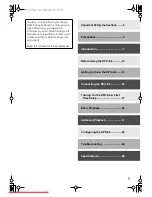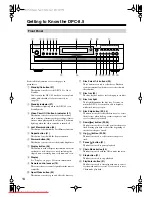
11
Introduction
—Continued
Handling Discs
• Never touch the
underside of a
disc. Always hold
discs by the edge,
as shown.
• Never attach adhesive tape or
sticky labels to discs.
Cleaning Discs
• For best results, keep your discs clean. Fingerprints
and dust can affect the sound or picture quality and
should be removed as follows. Using a clean soft
cloth, wipe from the center outwards, as shown. Never
wipe in a circular direction.
• To remove stubborn dust or dirt, wipe the disc with a
damp soft cloth, and then dry it with a dry cloth.
• Never use solvent-based cleaning fluids, such as thin-
ner or benzine, commercially available cleaners, or
antistatic sprays intended for vinyl records, because
they may damage the disc.
Storing Discs
• Don’t store discs in places subject to direct sunlight, or
near heat sources.
• Don’t store discs in places subject to moisture or dust,
such as in a bathroom or near a humidifier.
• Always store discs in their cases and vertically. Stack-
ing, or putting objects on unprotected discs may cause
warping, scratches, or other damage.
Copyright
It is forbidden by law to copy, broadcast, show, broadcast
on cable, play in public, or rent copyrighted material
without permission.
DVD-Video discs are copy-protected, and any record-
ings made from these discs will be distorted.
This product incorporates copyright protection technol-
ogy that is protected by U.S. patents and other intellec-
tual property rights. Use of this copyright protection
technology must be authorized by Macrovision, and is
intended for home and other limited viewing uses only
unless otherwise authorized by Macrovision. Reverse
engineering or disassembly is prohibited.
■
CD-R (compact disc recordable):
A type of CD
that can be recorded only once. Can be used for VCD,
CD, MP3, or JPEG.
■
CD-RW (compact disc rewritable):
A type of
CD that can be recorded over and over again. Can be
used for VCD, CD, MP3, or JPEG.
■
Chapter:
Titles on DVD-Video discs can be subdi-
vided into chapters.
■
Component video:
A video connection format that
separates the luminance (Y) and color difference signals
(P
R
, P
B
), providing better picture quality than S-Video.
■
Composite video:
A video connection format that
combines the luminance and color signals together.
■
Direct Digital Path:
Unique Onkyo technology
that uses dedicated shielded cables to connect the digital
audio outputs, protecting the digital output signals
against the possibility of noise and interference.
■
Dolby Digital:
Once known as
AC-3,
this is the
des-
ignated surround sound format for DVD-Video, HDTV,
and select digital broadcasts (cable, satellite, over-the-
air). A Dolby Digital bitstream may contain mono, ste-
reo, Dolby Surround, or 5.1-channel audio information.
■
Dolby Pro Logic:
The decoders used in home the-
ater equipment to decode Dolby Surround material.
See
Dolby Surround.
■
Dolby Surround:
The original Dolby surround-
sound format uses matrix encoding to deliver four chan-
nels (left, right, center, and surround) over two audio
channels. Can be used with VHS video, analog TV, and
other analog stereo systems. The movie theater version is
known as
Dolby Stereo
.
■
Downmixing:
The process of mixing multiple
audio channels into fewer channels. For example, a 5.1-
channel surround mix can be downmixed into two chan-
nels for reproduction on stereo systems.
■
Downsampling:
The process of reducing the sam-
pling rate of digital audio.
■
DTS (Digital Theater Systems):
Like Dolby
Digital, the DTS surround-sound format offers up to 5.1-
channels
of information,
but uses less compression for a
more faithful sound.
■
DVD-Audio:
The DVD format for storing up to six
(5.1) channels of 24-bit/96 kHz digital audio or two
channels of 24-bit/192 kHz digital audio.
■
DVD-R (DVD recordable):
A type of DVD disc
that can be recorded only once. Can be used for
DVD-Video or DVD-Audio.
Underside
✔
Terminology
Downloaded From Disc-Player.com Integra Manuals












































